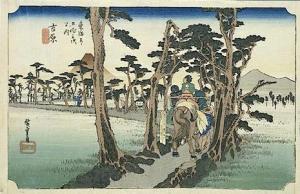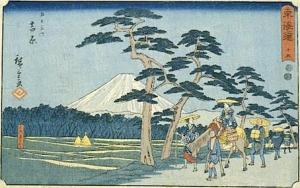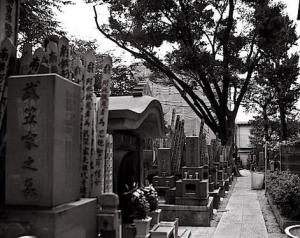Not far from Minowa station on the Hibiya line is a nondescript temple called 浄閑寺—Jokanji. From the street, it looks like many other Tokyo temples, but behind the new main building is an old cemetery that has one particular point of interest, a crypt and monument to twenty-five thousand prostitutes interred there. Being so close to Halloween, I was looking for a spooky story when my friend Joe mentioned the place.
I didn’t find a ghost story.
What I found instead was a very sad, shameful story about the women and girls used up by the sex industry of Japan. I’ve tried to make this story about the temple itself, but understanding the temple requires a bit of background on the times and the places involved, mainly that of Yoshiwara. This isn’t trying to be a history of Yoshiwara, as plenty of those exist. This piece is about my research into Jokanji, the Throw-Away Temple. I will add to this and make corrections as I find them. As always, I welcome any comment or criticism. There are a lot of parts I may include in the future, such as the nearby memorial associated with Nagai Kafu, a writer whose stories dealt with the lives of these women
During the Tokugawa era, in present-day Taito-ku, Senzoku 4-chome, there was a licensed prostitution area called Yoshiwara. The area had been moved from near Nihonbashi in the late 1650’s after a devastating fire leveled much of the city and the new area was known for a time as Shin-Yoshiwara. (新吉原, New Yoshiwara, though eventually the “New” was dropped and people simply referred to the area as Yoshiwara.) For 300 years, the area was home to thousands of women and girls, many of whom were sold by their families as young girls.
Yoshiwara was a walled-in, tightly-controlled area. Patrons entered and exited the area down a curving street headed by a gate not unlike the tori that stands at the entrance to the temple. Transactions were negotiated outside the walls, at nearby teahouses and even samurai were required to leave surrender their swords before they could enter. The women could not, of course, come and go as they pleased. Most were enslaved by debt they could never completely repay. During their service they could leave only for the death of a parent and once a year to view the cherry blossoms in Ueno. For most of the common prostitutes, the only real way out was through their own death.
On on November 11, 1855 the Ansei Edo Earthquake (安政江戸地震, Ansei Edo Jishin) a 6.9 magnitude earthquake struck Edo (The old name for Tokyo) with intermittent aftershocks over the next two weeks. The last major quake to hit Edo had been in 1703, so few if any of the residents of the area had ever experienced a major quake and hadn’t given any thought to earthquake safety.
Buildings collapsed and fires spread rapidly through the city. Unfortunately for the women enslaved in Yoshiwara as common prostitutes, if they had survived the building collapses, they were far more likely to die in the resultant fires. Yoshiwara, after all, was a walled village with only two exits, both narrow, to control the passage of people in and out. Fear of looting slowed the evacuation as well.
Woodcuts I examined at the Taito-ku Library in Kappabashi showed the fates of some of the different classes of people in Yoshiwara—one showed an elegantly-dressed Oiran or high-level courtesan being rushed from the area by two samurai. One samurai was on horseback and both had their swords, indicating that they had been dispatched to rescue this woman, as swords were not allowed in the quarter, even for samurai who were habitués of the brothels. Another print showed lower-class prostitutes clad in the common plain blue kimono that was mandated for working girls. (This rule was ignored by those whose status was higher.) The prints showed the lower classes, both men and women, panicking in the streets, crushed by heavy roof tiles and buildings, crawling through the streets in despair. One showed the interior of a brothel as it collapsed, women and customers tossed about mid-coitus, while a prominent sign on the wall says “火の用心” or “Be careful of fire.” Another showed looters, some themselves trapped under rubble, greedily swallowing gold and silver coins and later “recovering” them as they passed through their systems.
At the time it was a commonly-held belief that earthquakes were caused by an imbalance of the good and evil forces of Yin and Yang, so a major quake, to some, was a sign that social change was needed. (Often referred to as “correlative cosmology”.) The quake was centered northeast of the city and Yoshiwara, too, was northeast of the palace. In Buddhist tradition, the Northeast is known as “Kimon” or the direction that bad luck follows. In 1855, the Northeast of the city was the hardest hit by fires, with the West of the city largely untouched. Yoshiwara in particular was among the worst hit.
Yoshiwara went into a decline and the brothel owners’ profits fell. To counter this decline, the owners brought in more women and lowered prices. Conditions worsened and disease became the norm.
While there had been about fifteen-hundred women working there in 1700, by the turn of the 20th century, there were some nine thousand women working in the area as prostitutes, all in the same small quarter. Most of them suffered from syphilis or tuberculosis or both. Typhoid broke out occasionally. Rarely did a common prostitute live to see her thirtieth birthday. While some historians may glamorize the era in its heyday, life for most of the women working in the late 19th and early twentieth centuries was a miserable existence at best. There was a very high turnover.
At the time of the Ansei quake in 1855, there was a severe shortage of coffins, so much so that people resorted to using sugar casks and barrels as makeshift caskets for even the more wealthy of the dead, so for someone of such low social status as a common prostitute, there would be no such ceremony. Bodies were simply piled until they could be disposed of.
This certainly must have set a precedent for later. When a woman of Yoshiwara died, she died with little pity or notice. Brothel workers would take her body, wrap it in a cheap rush mat, carry her out and dump her at the gates of the nearby Jokanji temple. In all, an estimated 25,000 women were thusly interred. The practice became so common that the temple became known as “Nage Komi Dera,” (投込寺,) the “Throw-in Temple” with all of the connotations of being a dumping ground for unwanted, forgotten women.
Why Jokanji was chosen isn’t clear. It’s not the nearest temple and getting there while carrying a body would have required a fairly roundabout route, at least using the paths shown on maps of the times. Yoshiwara itself was surrounded by rice fields, fairly impassible most of the year. In November, the rice would have been cut to stalks and the ground itself a thick, sticky muck.
The most direct route would have required the use of the front gate, which I find hard to imagine, as it would have been quite bad business to carry dead prostitutes past incoming customers. More likely, the back entrance was used. A woodcut from the time by Hiroshige shows the area, with its narrow roads between the rice paddies.
View of Mt. Fuji from Yoshiwara, from Hiroshige’s 53 Stations of the Tokaido. This is be a Southwest-facing view, therefore from the rear exit of Yoshiwara. The visible road leads away from Jokanji, which is to the North. Most likely, they used unmarked service paths between the rice fields which would have offered a direct and discreet route straight to the temple, avoiding the streets.
Another view of Mt. Fuji from Yoshiwara, from Hiroshige’s 53 Stations of the Tokaido. In this view, walkable paths in the fields are visible. These paths do not appear on period maps, but may have afforded a passible, discrete route from Yoshiwara to Jokanji.
(Note: a reader has noticed a discrepancy with the accuracy of the old prints. We are looking into it now, cheers)
Around the turn of the century, as Japan opened up after the Meiji Restoration, international pressure started to force some changes to the area. By Meiji 38, (1905,) the practice of dumping bodies there was largely stopped and a monument to the women was erected at Jokanji, but it’s reputation as a dumping ground and the nickname “Throw-in Temple” (nege-komi-dera) stuck.
When I first went looking for the place, I wandered a bit before asking a pair of shopkeepers for directions. “I’m looking for Jokanji. A temple in this area…”
“Jokanji? I don’t know it…” the more senior of the two said.
“It’s the throw-in temple,” the assistant offered. “not far from here.”
“Ah, yes—of course!”
He then directed me a couple of blocks away to the entrance to the place. I parked my bicycle outside the temple, becoming a bit dubious that there would be anything worth seeing, as the building is quite new and modern. As you enter the grounds, there is a long wall to the left, behind which is the temple’s cemetery. It’s like most other neighborhood cemeteries, narrow lanes of plot after plot of family monuments. I hadn’t thought of this at first—I had assumed the place would be devoted to the victims of Yoshiwara, but the bulk of the space was used by normal families, most with no likely connection to the mizu shobai or water trade, the sex industry in old Edo. It was, after all, a cemetery before Yoshiwara and continues as one to this day.
A temple worker saw me wandering among the plots and waved me over to the back. “It’s over there” he explained, knowing that I was most likely looking for the monument, without my asking. Once you turn the corner, the monument is obvious, much larger than any of the family memorials. Further down the lane is a large tree. The temple worker explained that the old entrance to the graveyard was beyond that tree and that’s where the bodies were typically dumped.
It’s a grim place on a late October day, so close to Halloween, though there are fresh flowers every few days and ritual incense is burned each day. On the left are sotoba, the wooden sticks that typically bear the deceased’s Kamiyo, the name the person is given after death in the Buddhist tradition. (As most of the souls inside were anonymous, I don’t know whose names are upon these sticks.)
Each day I went there to photograph the place, I’d see a couple of Japanese sight-seers come by with digital cameras to take a few snapshots.
Atop the monument is a seated Buddha holding a staff with six rings affixed to the top. The pillar behind is deeply inscribed “Shin-Yoshiwara-Soureitou,” (新吉原總霊塔) roughly meaning simply “Shin Yoshiwara Memorial.” An older photo of the memorial shows the pillar alone, sitting atop its stone lotus base, indicating that the Buddha figure was added later.
A small shrine sits at the base in the front, with an offering plate (¥7 was in it when I visited) and a place to burn incense, cups of sake and flowers.
Above the standing figure is a red lacquer ‘Hira-Kanzashi’ hair ornament of the type a girl in Yoshiwara might possess, affixed to the wall.
Hira-Kanzashi’ hair ornament
Along one side there are a couple of small, barred windows, through which you can see earthenware pots containing the ashes of some of the people interred there. Along the other side is a locked iron door, leading to the interior of the crypt. Through the bars, if you let your eyes adjust for a few minutes, you can see that it’s quite large inside. Just inside the door is an iron ladder leading down about three meters to the floor. The walls are lined with shelves on which the pots were stored, but for the most part, empty, as the jars most likely fell and broke in later earthquakes.
Crouching near the window of the door, trying to get a photo, I could smell the interior of the crypt, a cool, earthy smell. It’s much like the smell of an earthen basement, but not quite. It was a familiar smell though, one I’d smelled before, but couldn’t place. I realized after a bit where I’d smelled it before – it was the scent of the bones I’d smelled in the catacombs below Paris. Matt Treyvaud, of No-Sword was kind enough to provide a translation of part of the inscription on the Nagai Kafu memorial I mentioned. I don’t know a lot about Nagai, so I felt remiss in neglecting him; I’m happy to have this, as he’s obviously an important chronicler of the place and time.
Young people of this world
Do not ask me about this world’s
Art or arts of any times to come.
Am I not a child of Meiji?
When those ways became history, were buried,
The dreams of my youth vanished too
The last of Edo’s ways are become smoke.
Meiji culture, too, is become ash.
Young people of this world
Do not speak to me of this world’s
Art or arts of any times that may come.
I could clean my clouded glasses
But what could I then see?
Am I not a child of Meiji?
Am I not a child of long-ago and long-gone Meiji?
I had hoped to dig into that a bit more, but haven’t yet had a chance, so I appreciate his help in this.
On another note, as we walked through Minowa, Jokanji and Yoshiwara today and at the end of the day we exited Yoshiwara through what was once it’s back gate and found ourselves at the spot from which Hiroshige had drawn the first image in this post:
I have no doubt that it’s the same spot as in 1830, there was no other road leading from that side of Yoshiwara. Luckily I have an image on my ipod for reference and it was a remarkable moment.
Thankyou to Jim for writing about this topic, as sad as it is.
Edited for Rekishinihon by Stuart.









Reblogged this on 夢日記 and commented:
This is a really fascinating article on an area of Japanese history I must admit to not being particularly aware of.
LikeLike
Thankyou for reading.
LikeLike
No problem! You’ve given me another place to visit while I’m in Tokyo.
LikeLike
Hi, I found your site through one of Facebook pages and I am really curious about the old Japan, so this has been a very interesting article. 25.000 women…It’s extremely tragic…I would like to read the novels by the author mentioned above on these Yoshiwara people.
LikeLike
I have noticed you don’t monetize your blog, don’t waste your traffic, you can earn additional bucks every month.
You can use the best adsense alternative for any type of website (they approve all websites),
for more info simply search in gooogle: boorfe’s tips monetize your website
LikeLike
Moncler | Men’s Women’s Coats & Jackets for Sale Luxury Fashion �C lassic moncler jacket outlet Online Sale. A collection of 100 items moncler jacket outlet Free Worldwide Shipping!
[url=http://www.canadagooseonlinesale.com/]Canada Goose Jackets Sale USA[/url]
Canada Goose Jackets Sale USA
LikeLike
Thank you for writing this. It’s so very sad. I hope to visit someday myself.
LikeLike
Yes, it is a sad part of Edo life and the Yoshiwara district. Thankyou for reading.
LikeLike